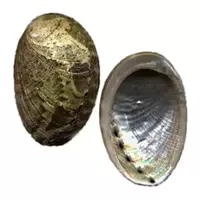Sea ear

The sea ear or in some variants, the abalone is a fairly large mollusk belonging to the gastropod subspecies. It is worth noting that such a species as gastropods is considered the most numerous among all molluscs. In essence, soft-bodied or mollusks are the so-called primary and coelomic animals, which are distinguished by spiral crushing.
Currently, official science knows over two hundred different species of mollusks. It is noteworthy that the mollusks were able to master all possible habitats on planet Earth. In addition, mollusks can successfully live in both salty sea and fresh river or sedentary lake water. The gastropod marine ear or Haliotis is distinguished by the presence of a flat shell that reaches a length of 20 cm.
The marine ear mollusk is of important commercial importance. The species is grown, and also caught in the coastal waters of the United States, namely in the state of California, as well as in the countries of Indochina. The sea ear mollusk is especially popular among noble fish and seafood lovers in Japan, as well as China. Such a seafood as sea ear is consumed in dried as well as salted form.
In addition, abalone mollusk is eaten fresh. What is noteworthy, when using abalone fresh, the mollusk should still be alive when cooking. The process of preparing fresh shellfish should take no more than 30 seconds, otherwise the product is considered hopelessly spoiled. The thing is that dark brown in color meat of the sea ear very quickly after the death of the mollusk becomes tough and unpleasant to taste.
That is why the sea ear is often cut into strips and frozen. Thin strips of clam are thought to be better able to be cooked. In the national culinary tradition of Asian countries, there are a fairly large number of recipes for preparing shellfish sea ear. Culinary professionals can create a real masterpiece with the participation of a sea ear.
As a rule, sea ear is used in the process of preparing soups, snacks, salads, as well as main dishes from fish or seafood. It is considered an ideal combination of stewed together sea cabbage and sea ear, which is pre-rolled in flour and fried necessarily in butter. A real masterpiece of culinary excellence is considered a regular chowder with a clam or steamed sea ear.
sea ear 0.1 kCal
Energy value of the sea ear (Ratio of proteins, fats, carbohydrates - ju):
Proteins: 0 g (~ 0 kCal)
Fats: 0 g (~ 0 kCal)
Carbohydrates: 0 g (~ 0 kCal)
Energy ratio (b | y): 0% | 0% | 0%
 Español
Español Français
Français Português
Português Русский
Русский 简体中文
简体中文 繁體中文
繁體中文 日本語
日本語 한국어
한국어 العربية
العربية Türkçe
Türkçe Қазақ
Қазақ Deutsch
Deutsch Italiano
Italiano Українська
Українська
